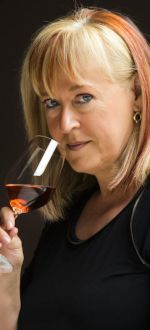Women and wine: 5 stories of women producers
No simple rosés or sweet wines! Women demand elegant wines with personality. The women of wine prove it: the women who make them. Here are our favourite women winemakers!

Skilled entrepreneurs and refined oenologists. But that's not all. Women in wine making express a connection with the territory never seen before. And it is no coincidence that all over Europe it is women-run wineries that stand out for their innovation, precision of style and ability to interpret the tastes and times of wine. These are solid, tenacious women who give us wines with character, wines that are convincing on an international level, even if they come from small districts, working with artisanal methods and on family wineries with indigenous grapes and impervious soils.
Arianna Occhipinti (Sicily)
Arianna Occhipinti is a young, determined and charismatic Sicilian who, starting with her degree in oenology, decided to dedicate herself to what she loves most: her land, her vineyards, her wine. The land extends in the heart of the Cerasuolo di Vittoria area, in the Monte Iblei scenario, in the Fossa di Lupo and Piraino districts. They are very ancient lands, where the frappato di Vittoria and the Nero d'Avola originated. Arianna's biggest challenge is to understand the needs of the land, without disturbing its future or changing its appearance, trying to gather what it can offer. The rigour and harmony of Nero d'Avola derive from the mineral terroir, the sea air and the drought that characterise this part of Sicily. And also the freshness and elegance of frappato, which Arianna has contributed decisively to rediscover, derive from nothing else but grapes.
These wines carry with them the characteristics and stories of their land, which Arianna loves, and which she is committed to preserving and safeguarding, using conscious and sustainable cultivation techniques. Old vineyards that produce wines with a clear and sincere style. In the single varieties, what stands out are the Nero d'Avola Siccagno, which is broad, persistent and beautifully spicy, and the Frappato, perhaps Arianna's great wine, austere, subtle, terse and mineral, almost a Pinot Nero di Vittoria. Apart from the magical Cerasuolo di Vittoria, a blend of Nero d'Avola and Frappato aged in large barrels, which is intense, fruity, and elegant, the blend of the same grapes produces the crunchy, young and typical SP68 Rosso, versatile, immediate and delicate. The SP68 Bianco is instead an original, snappy and dynamic blend of zibibbio and albanello, a native variety rediscovered by Arianna.
La Universal (Montsant)
La Universal is the small 4-hectare estate located in the Falset district where two weighty names in the wine world have come together: René Barbier (he is the 4th generation, with more than 20 years of experience in the family-run winery of Clos Mogador) and his wife, the assiduous oenologist Sara Pérez, daughter of Josep Lluís Pérez (Mas Martinet Viticultors). Under the Montsant D.O, the couple have put together a joint project there, which is characterised by its adherence to the very strict parameters of organic agriculture and respect for the environment (a philosophy which is followed in the vineyard and winery, but is also carried through to logistical matters such as transport, bottling, etc.).
When the expertise of two families with deep Priorat roots, the Pérez and Barbiers, is united and this is combined with a love for the land and the readiness to cherish its fruits felt by two people like Sara Pérez and René Barbier, the end result is a wine that's unpretentious but exciting.
Sara and René are a knowledgeable and approachable couple, whose main aspiration as they go through life is to leave an emotional mark, not a material one, and with this aim in mind they devote themselves to looking after their own environment, and that of those they meet along the way, with complete sincerity and affection. In favour of the ecosystem, they moved over to organic cultivation years ago and viewed sustainability as a non-negotiable goal, reducing waste to the minimum, employing lower-energy materials and restructuring water and electricity consumption. In their dealings with others, they are always kind, considerate and smiling, delighted to chat about wine at any time.
Dubreuil-Fontaine (Burgundy)
Owned by the Dubrueil family for five generations, the Domaine Dubreuil-Fontaine winery is currently managed by the oenologist Christine Gruère-Dubreuil. The extraordinary estate, over 140 years old, is located at the meeting point of the Côte de Nuits and Côte de Beaune regions, near the spectacular village of Pernand-Vergelesses and the Grand Cru vineyards around the Corton hillsides.
Legendary names of Burgundy wine, which sound majestic to any wine lover. Yet Christine's philosophy is to offer these wines at the right price, without going overboard, despite the uncompromising quality and very low quantity of the winery's product. Christine has been at the helm of the domaine for thirty years. Since that distant 1991, when, after dabbling her way around the world in the wine trade and oenology, she achieved her lifelong dream of rightly becoming a member of the staff alongside her father Bernard. Now her young daughter Clémentine, is also part of the winery, giving further impetus to the domaine's eco-sustainable and artisanal approach.
Among Christine's merits, there is certainly the intuition to create a range of Burgundies by working more on subtraction than addition. Less wood, with ageing reduced to 18 months, and less new wood, reduced to 30% of the mass for the grand crus. At the same time, Christine has introduced temperature-controlled steel vinifiers, replacing wooden vats: a choice geared towards a more straightforward, varietal, natural style, in short, less artificial, to combine fleshiness and finesse in a single glass.
Christine works with his daughter Cleméntine supervising the harvest and selection of the best Chardonnay and Pinot Noir grapes, their manual pressing, and the careful vinification process aiming to create natural wines. The winery produces Grand Cru de Corton red and whites, as well as a range of splendid 'village wines' and other Premier Cru wines from the nearby vineyards at Côte de Beaune: Volnay, Pommard, Beaune, Aloxe-Corton, Savigny-Les-Beune and Pernand-Vergelesses.
Suavia (Veneto)
Suavia is a winery currently run by the Tessari sisters and figures among the pioneers of Soave, in the province of Verona. Founded in 1982 thanks to the vision of Giovanni, whose family forebears in the world of wine date back to the 19th Century, the winery became a quality benchmark for the region right from its beginnings. The Tessari sisters, Arianna, Valentina, Meri and Alessandra, have taken on different roles in the winery's management and made the Garganega variety and the volcanic soils found locally the characteristic trademarks of their products. To achieve this they can count on their magnificent Fittà cru vineyards, located at an altitude of 300 metres with excellent sun exposure and marked differences in day and night temperatures, thus favouring good growth.
The winery contains efficient, modern installations set up for the production of white wines that feature amongst the most highly-esteemed in the world. Mineral, elegant and easy to drink wines, which express the best of this volcanic terroir with its own personality and with an interpretation of the Garganega variety that's always original.
Matured in contact with its lees, Soave Classico is a floral wine, fruit-forward and vertical. Monte Carbonare is a very select wine which has established itself with successive vintages as a great Soave,vigorous and profound, with notes of almonds and eucalyptus fusing sublimely. With Le Rive the winery has created a Garganega that combines tradition and international taste: a late-harvest wine which ages in large barrels and offers an aromatic display highlighting peach jam and an opulent, rounded and smooth palate. The winery's premium products are Recioto di Soave Acinatium, made using Garganega grapes left to dry out naturally or by special process for six months, fermented and aged in oak barrels and in contact with its lees for two years; and Massifitti, produced from Trebbiano de Soave and matured for 15 months in steel tanks and in contact with its fine lees, and undergoing a further 12 months of refinement in bottle.
Campo Viejo (Rioja)
Campo Viejo is one of the Rioja region's most well-established names and produces on its premises three premium brands that sell in over 70 countries: Campo Viejo, Azpilicueta and Alcorta.
Since its foundation in 1959, Campo Viejo has undergone constant evolution, combining in a very effective way an artisanal treatment of its wines with the most cutting-edge technology as well as respect for its immediate surroundings and the environment. Evidence of this is shown by the new premises themselves: the building conceived by the La Rioja architect Ignacio Quemada, and the winery designed so that it fulfilled criteria set by the head oenologist, Elena Adell. This new winery, opened in 2001, brings together contemporary architecture, precision engineering and 21st-century winemaking. A masterpiece concealed more than 20 metres underground, which provides it with the ideal conditions for ageing wine, where work is carried out in keeping with the most up-to-date requisites of high quality, but always adhering to the Rioja's authentic tradition. The Campo Viejo winery is a benchmark in sustainability: totally integrated into the landscape, it has been recognised on numerous occasions for its respect of the environment.
For producing the wine of all its brands, Campo Viejo has recourse to 1,900 hectares of vineyards, which are located at different altitudes and on soils of varying composition. The majority of its vineyard plantation is comprised of old vines, aged over 25 years old, with Tempranillo the main variety grown. Each brand has a different focus: Alcorta primarily utilises the Tempranillo variety from areas within Rioja Alta; Azpilicueta uses solely grapes sourced from Fuenmayor, a town in Rioja Alta, specifically Tempranillo, Graciano and Mazuelo; and Campo Viejo takes grapes from all over the denomination, from Rioja Alta, Rioja Baja and Rioja Alavesa, making use of all of the varieties. To put it briefly, interesting and expressive wines which reflect La Rioja's vivacity and colour.
But these stories never end...
...in fact, we can suggest many other wineries around Europe that confirm the level of solidity and quality of the women wine movement. From Catherine Corbeau-Mellot in Sancerre to Anne-Laurence Chadronnier in Bordeaux, for France. Giulia Negri, Elisabetta Foradori, Marisa Cuomo, Elena Fucci, for Italy from Barolo to Vulture, passing through Alto Adige and the Amalfi Coast. For Spain, you must pop in to see Marisol Bueno, owner and founder of Pazo de Señorans (Rías Baixas), Anne Cannan, oenologist at Clos Figueras in Priorat and Victoria Pariente, founder of the iconic Bodegas José Pariente in Rueda.
















